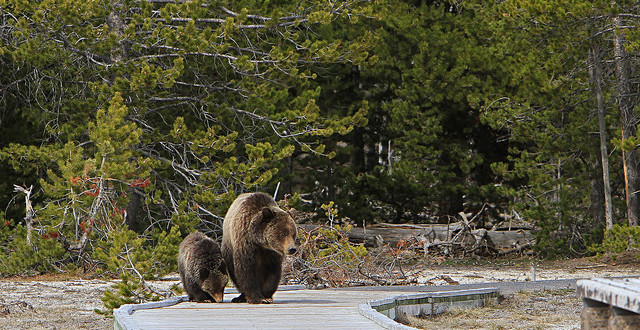The U.S. Fish and Wildlife Service has announced it is removing Yellowstone area grizzly bears from the Endangered Species List.
The move comes nearly two years after then-USFWS director Dan Ashe signaled to state wildlife agencies his agency was mulling a removal of protections. It also marks the second time in a decade Yellowstone grizzlies have had protections removed. We previously reported a decison was expected by the end of June.
The previous attempt was made in 2007; however, Yellowstone grizzlies were put back on the list after a U.S. District Court judge ruled the USFWS had not adequately considered the impact of climate change on whitebark pine nuts, a grizzly staple. Since 2009, the USFWS has worked to change its delisting plans to accommodate this request.
Yellowstone grizzlies have been on the Endangered Species List since 1975, when fewer than 150 bears lived in the Greater Yellowstone Ecosystem.
According to the New York Times, Interior Secretary Ryan Zinke hailed the comeback of Yellowstone grizzlies as “one of America’s great conservation successes; the culmination of decades of hard work and dedication on the part of state, tribal, federal and private partners … As a Montanan I am proud of what we’ve achieved together.”
Others were not so pleased. Indeed, in a press release from WildEarth Guardians and the Western Environmental Law Center, advocates for grizzly protections railed against the delisting decision as premature, saying it would endanger the bear’s future viability:
Kelly Nokes, carnivore advocate for WildEarth Guardians and Matthew Bishop, attorney and Rocky Mountains office director for the Western Environmental Law Center who represents Guardians in a forthcoming challenge to the decision offered the following statement in response to the Service’s announcement:
“The Service is derailing the recovery of this iconic species by prematurely stripping the Greater Yellowstone Ecosystem grizzly bears of federal protections. As a result of today’s announcement, Yellowstone’s bears may soon face a trophy hunter firing line once they roam outside the safety of our beloved national parks. The Service’s decision today flouts the letter and intent of the Endangered Species Act, ignores the best available science, and undermines the recovery of this cherished species as a whole. Grizzlies in the Greater Yellowstone Ecosystem remain threatened by dwindling food sources, illegal poaching and record-high mortality rates, genetic stress from a lack of connectivity to neighboring sub-populations, and the burgeoning threats of climate change. It is essential for the recovery of grizzly bears as a species throughout the lower 48 that the GYE bears disperse into neighboring sub-populations and still unreclaimed habitats. Now is not the time to strip these bears of vital federal protections.
Bishop told the Times his organization plans to sue the USFWS after the 60-day waiting period that follows such agency announcements.
Not everyone of the “conservation community” is as concerned as Bishop and Nokes, however, according to the Times:
Even the conservation community is split on the delisting. While some groups are adamantly opposed and say the future of the species is still at risk, others consider the bear recovered and say it should be delisted.
“It’s recovered under any metric we look at,” said Tom France, regional executive director for the National Wildlife Federation in Missoula, Mont. “We should consider it a great success.”
Part of the concern for delisting grizzlies now is that all the grizzly populations across the Western continental United States are isolated. Besides Yellowstone, there are populations around Glacier National Park, the Bitterroot Ecosystem, and the North Cascades ecosystem, as well as sub-populations in the Selkirk and Cabinet-Yak ecosystems. This connectivity, former Interagency Grizzly Bear Study Team researcher David Mattson explains, is essential toward the survival of not only Yellowstone grizzlies but the grizzly bear as a whole.
Severe criticism of delisting has also come from Native American tribes across the West, many of whom signed a treaty last year aligning themselves against any delisting decisions.
Yellowstone Superintendent Dan Wenk has also spoken out against grizzly delisting, saying it would negatively impact bear tourism in the park. Wenk, along with a researcher with the University of Montana, also called into question the methodology the USFWS used to calculate bear populations.
State wildlife agencies have voiced support of delisting, citing concerns from residents and ranchers that more grizzlies would equal more conflict and possible injuries/deaths. Under the current agreement, state agencies would be monitored for five years to ensure they comply with management regulations. And if Yellowstone’s grizzly population falls below 600, stringent regulations would go into effect until the population rises.
 Yellowstone Insider Your Complete Guide to America's First National Park
Yellowstone Insider Your Complete Guide to America's First National Park





